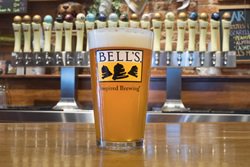How a simple point level measurement saw through the foam
Bell’s Brewery knows beer. With the eight different beers they brew year-round and even more seasonal and specialty brews, you could say they have a passion for making high-quality, consistently satisfying beer.
Walking through Bell’s state-of-the-art brewery in Comstock, Michigan, visitors are dwarfed by the lines of massive stainless steel tanks – some a story or two high. More observant eyes will notice the significantly smaller sensors and transmitters providing vital data enabling operators to control the multiple ongoing brewing processes.
Of all the sensors inside Bell’s Brewery, however, only one is highlighted with a bright LED indication ring – the VEGAPOINT 21. This point level switch is special for a couple of reasons. It’s the first of its kind to be installed in the United States, and it’s located on a foam trap tank in the newest addition of the growing brewery.
The foam trap – achieving the perfect pour
With every batch, beer ingredients ferment, and as they ferment, carbon dioxide (CO2) forms. The right amount of CO2 is good for beer. It’s a sign of healthy fermentation, which turns sugars into alcohol and gives it the sudsy quality we all know and love. During this process, however, excess CO2 forms, and it needs a place to go. That’s where the foam trap comes in. 
The CO2 gas can’t be directly vented into the cellar space where people are working because it would create a dangerous work environment. The CO2 can’t be directly vented outside, either, because beer foam commonly travels with the gas. Instead, as pressure builds in the fermentation vessel, the excess CO2 and some foam travel into the foam trap.
As the excess CO2 and the foam fill the foam trap vessel, the foam is suppressed by spraying water on top of it with a spray ball. At the same time, a valve at the bottom of the vessel opens and drains the excess water.
Without any instrumentation on this vessel, the spray ball would constantly run water, whether excess foam was present or not, only to eventually flow down the drain. Operating the foam trap this way wastes water, and Bell’s saw this as an opportunity to reduce their water consumption. Operators worked with their sustainability department to find a solution.
A new innovative, sustainable solution
Brewery operators recognized they only needed to spray water when the foam rose too high, but they also needed to maintain a certain water level to prevent any CO2 from escaping through a side vent pipe and into the cellar space. To achieve overall control of the process, they needed two point level switches – one that could switch the spray ball on when it sensed the foam was too high and another that would switch the spray ball on if the water level dropped too low.
At the same time, VEGA was preparing to launch a new set of compact, affordable point level switches specifically designed for the food and beverage industries. The VEGAPOINT series of capacitance switches hadn’t been launched yet, but VEGA Americas had a few early samples available. After learning about Bell’s Brewery’s latest challenge, VEGA recommended the upcoming VEGAPOINT 21 to ensure the water level remained at a safe level.
The VEGAPOINT 21 is a capacitance point level switch for the detection of water-based liquids. Capacitance technology measures a medium’s ability to hold an electrical charge, which gives sensors using this technology the unique ability to differentiate between liquid and foam. Plus, the VEGAPOINT sensors come equipped with a three-wire transistor output – perfect for controlling the spray ball.
Bell’s installed the new VEGAPOINT 21 at the side of the foam trap vessel, and since every VEGAPOINT sensor is equipped with secure Bluetooth connectivity, installers configured and set up the sensor using their smartphone. With accessibility right at the sensor, setup was quick and easy – no need to make multiple trips between the sensor and the controls system during commissioning.
And finally, the VEGAPOINT 21 comes equipped with a bright LED ring, which can be seen from any direction and in any light. Operators can choose from 256 different colors to coincide with their process status: process is running, sensor is switched, or process error. With a quick look, operators can see the color of the light and know what’s happening with their process.
This final feature was especially helpful to Bell’s Brewery, adding another layer of safety to the foam trap. When the LED is on, operators know the tank’s water level is at a safe level, and thus preventing any CO2 from escaping into the cellar space.
Related products
Conserving water wherever possible
With the sprayer recently automated using the VEGAPOINT 21, Bell’s was using less water, and operators were confident the water inside the foam trap remained at a safe level. The VEGAPOINT 21 was able to differentiate between the foam and the water in the tank, only switching the spray ball on when it was necessary. By installing sensors and automated valves and programming all their foam traps to run this way – instead of 24/7 – Bell’s Brewery has saved 15 million gallons of water.
The foam trap is a small, but important, process. And for Bell’s Brewery, no process is too small to improve upon. Every day, they focus on brewing the best beer possible using systems and processes that provide economic, environmental, and social benefits. By working with VEGA, a company dedicated to helping industries operate more efficiently through innovative solutions, Bell’s Brewery created an opportunity to reduce their environmental footprint even further.
Export this article
Download as PDFShare this article
Comments ({{comments.length}})
{{getCommentAuthor(comment, "Anonymous")}} {{comment.timestamp | date : "dd.MM.yyyy HH:mm" }}
{{comment.comment}}

.jpg?rev=cf24540e751c44cc9711b2c4f9574e0b&mw=900&hash=338620AA2ADF4B7E1F7C10245560732F)




